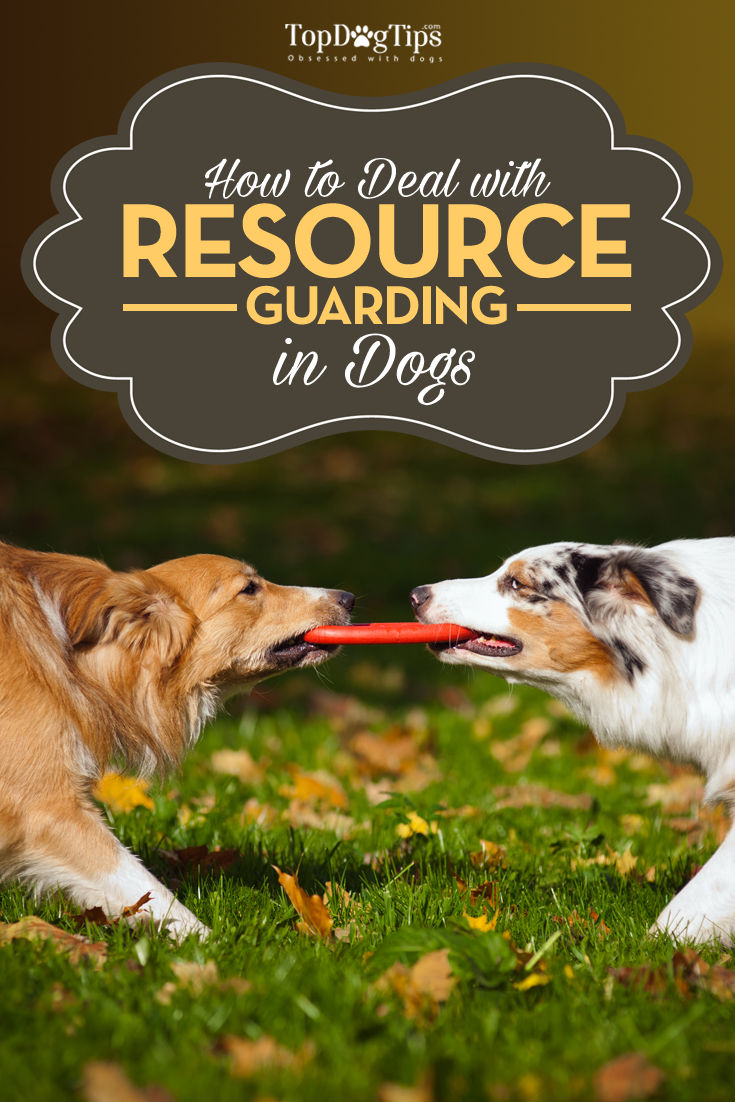 Resource guarding in dogs is the term used when a dog shows behaviors such as growling or snapping to convince humans or other animals to stay away from a resource the dog has. This may be dog food, toys, bones or treats – anything special that the dog has and does not want anyone else to take. Some pet owners chalk this behavior up to a dog's natural instincts, but the truth is that resource guarding is a very dangerous behavior that needs to be corrected.
Resource guarding in dogs is the term used when a dog shows behaviors such as growling or snapping to convince humans or other animals to stay away from a resource the dog has. This may be dog food, toys, bones or treats – anything special that the dog has and does not want anyone else to take. Some pet owners chalk this behavior up to a dog's natural instincts, but the truth is that resource guarding is a very dangerous behavior that needs to be corrected.
It is a natural behavior in dogs, as they have evolved from opportunistic feeders. This just means that wild dogs tend to eat whenever the opportunity arises, because they never know where their next meal may come from. Domesticated dogs still food (and other things they deem special) as a resource that they need to protect.
Usually, with proper training and exposure as a puppy, a dog will learn that resource guarding is not an acceptable behavior. In some cases, the dog may not learn this as a puppy or the desire to guard resources may be stronger than average. This can lead to a very dangerous situation and you should address this behavior problem with a professional to ensure your safety.
How to Deal With Resource Guarding in Dogs

Resource guarding is one of the leading causes for canine aggression towards humans. Resource guarding is also one of the most common reasons that dogs bite children. Your dog needs to understand that he must be willing to give up any of his possessions to a human, even if it is a very small human.
Here are eight best tips on how to deal with resource guarding in dogs from some of the most reputable and respected dog websites on the internet.
1. YourDogsFriend.org
You need to understand exactly what resource guarding in dogs is and what it looks like. Your Dog's Friend has published this blog post explaining the behavior and why it is so dangerous. The post explains that some dogs only guard the items that they have within their possession, while other dogs will guard resources in their general vicinity.
- Some dogs only guard what they are actually holding (a toy or bone, for example) or when they’re eating. Other dogs guard toys or treats in their general vicinity, even when they don’t seem all that interested in them. A few dogs guard space, like the couch or bed.
2. ASPCA.org
Food guarding is certainly the most common type of resource guarding. To learn more about this specific behavior you can read this extensive article from the ASPCA. Because you are certain what item the dog will be aggressive while protecting, it is easier to control food guarding than general resource guarding.
It's still a behavior that should be corrected, and the ASPCA gives some tips and tricks for doing that. However, they also explain that in some situations it is easier to find a way to deal with the matter that keeps everyone safe, especially if you have an older dog that has been expressing this behavior for many years.
- In many cases, food guarding doesn’t need to be treated. Plenty of pet parents with food-guarding dogs simply take reasonable precautions to ensure everyone’s safety. They leave their dogs alone while they’re eating, or they might even feed their dogs in a separate room, in a crate or behind a barrier.
3. Paw-Rescue.org
Sarah Wilson has written a blog post for paw-rescue.org that explains how to prevent or stop resource guarding using a technique developed by dog trainer Pat Miller. Of course, teaching a puppy that resource guarding is an unacceptable behavior would be much easier than trying to correct the behavior in an adult dog. Either way, taking the time to work with your pet is the only way to keep yourself and your family safe.
- To prevent the development of resource guarding, teach your dog to tolerate the presence of people and other animals around his food bowl, toys, bed, and other things he might regard as having high value. Teach your dog to trade good stuff for better stuff, then give him the original good stuff back. You want him to respond positively to your approach. For dogs who already exhibit guarding, modify the behavior with Miller's 10-step program. The time is worth it.
4. RSPCAVIC.org
The RSPCA of Victoria explains the importance of interacting with your dog while he's eating in this article. Many pet owners don't realize that they usually just put their dog's food down and then walk away. The dog always eats by himself, and thus doesn't like to have people around him when he is having his dinner.
- When we feed our dog from a bowl, we usually place the food down and then walk away. Sometimes, the only interaction that we have with our dog when it is eating is to take something desirable from it! A dog that consistently eats alone is more likely to resent intrusions to its meals at a later date.
5. HomewardBoundGoldens.org
If you adopt a puppy, it's crucial to teach him that he has no reason to guard any resources. This article from Homeward Bound Golden Retriever Rescue explains some great ways to work with puppies to prevent resource guarding issues.
Your dog needs to learn that it is expected that he will turn over any of his possessions to you at any time. In order to train him to do this, you simply need to teach him to “give” whenever he has something in his mouth.
- Teach him “take then give.” Practice “out” with your pup: Walk up when he is chewing a toy and say, “out”, and take the toy and then praise him for his brilliance. Immediately give him a treat. Return the toy and walk away. A few weeks of this once or twice a day and your dog will want you to come and take his toys.
6. PeninsulaHumaneSociety.org
As this article from The Peninsula Humane Society & SPCA states:
- Go slow. All too often, owners rush this process. It’s important to keep in mind that every time the dog growls, you’re setting back his progress and you must take a few steps back yourself
7. NJSheltieRescue.org
Joan Orr and Teresa Lewin are the co-founders of Doggone Safe, a non-profit organization for dog bite prevention education and victim support. They wrote this article for the Canadian Association of Professional Pet Dog Trainers Newsletter. It has some very helpful tips for helping to work with your children to train your dog that resource guarding is inappropriate.
Often, adults are the ones that train the dog, so the dog learns that they only need to listen to adults. The dog may act completely different around a child. In the case of resource guarding, you want your dog to understand that it is an unacceptable behavior no matter who he is doing it to.
- Another important lesson you can teach is the exchange. Instruct your students to obtain two identical bones or Kongs and to stuff them with goodies and give one to the puppy. They can then take the other bone or Kong and get the puppy interested in the second one and take the first one away. The puppy will soon get the idea that people taking things away is a good thing.
8. ClevelandAPL.org
The Cleveland Animal Protective League also shares a great 7-step training plan for teaching a dog that resource guarding is not an acceptable behavior. The plan is designed specifically for food guarding, but you could adjust it to meet the needs of any resource guarding in dogs.
- If you think your dog is at risk for biting, get the help of a behavior professional. It can be dangerous to work with a dog who guards food, and safety is your first priority. To treat food guarding behavior, follow the seven-step plan below. Move on to the next step when your dog is able to relax for ten meals in a row.
Now it's your turn!
Have any other resources to share, or tips and advice for dog owners? Let us know in the comments below and let's discuss!













